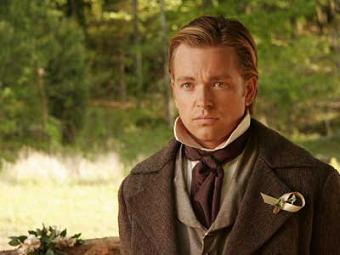

The most ambitious movie in the history of Mormon cinema just got more ambitious. The success of The Work and the Glory prompted two sequels, starting with this one, The Work and the Glory: American Zion, based on the novel Like a Fire is Burning by Gerald N. Lund. And if both of these do well, Lund still has more novels to adapt. The novels fictionalize the formative years of the Church of Jesus Christ and Latter Day Saints. As a sequel, American Zion improves on some of the faults of the original, yet director Sterling Van Wagenen (Amy & Naomi) manages to come up with some new ones.
American Zion picks up right after the events of the first film. Joseph Smith (Jonathan Scarfe, The Work and the Glory, Judas) is finding an increasing number of converts to his new religion. The level of mistrust amongst non-believers also continues to grow, so much that he decides to move all of his followers from Palmyra, New York, to Kirtland, Ohio. Van Wagenen and adapter Matt Whitaker (Saints and Soldiers, Truth & Conviction) use the events to slowly increase the tensions between the Mormons and their enemies. This period in Mormon history is uniquely interesting, as they did face much discrimination at the hands of others. However, American Zion completely drops the ball by not explaining why.
The story makes little to no mention of why everybody hates the Mormons. Van Wagenen and Whitaker make no attempt to explain the basic beliefs of Smith. This essentially guts much of the film for anybody not familiar with American history or the Mormon church. Okay, so people seem to hate the Mormons. Why? Aside from the fact that Smith started a new religion, it's never clear. It also makes the Smith character seem a bit hollow. Why is everybody following him? He does perform a miracle or two, but the script is just as likely to make him crack a witty one-liner. Once in Kirtland, most of his followers agree to build a new temple before they build housing for themselves. This implied charisma or power that Smith has does not come through in the script or in Scarfe's performance. Scarfe has improved since his last outing, and really comes into his role late in the film, once prolonged violence seems to change the way Smith acts against his enemies.
Benjamin Steed (Sam Hennings, The Work and the Glory, The Aviator) does not see why either. Steed is watching his family rip apart through this new religion. His wife and son Nathan (Alexander Carroll, The Work and the Glory) are fervent believers, but his other son Joshua (Eric Johnson, The Work and the Glory, Ginger Snaps: Unleashed) vehemently detests the Church to the point of violence. Henning is the strongest actor here, and his performance does bring some emotion to the story. As violence against Mormons mount, he finds his two sons cast against each other. It also helps that Carroll, a weak actor, has a diminished role.
American Zion also suffers from 'middle sequel' syndrome. It fits as a piece of a larger story, but fails to stand on its own. Van Wagenen and Whitaker, who are also directing and adapting the third film, move the story forward and introduce new characters that will presumably play a part later, like some guy named Brigham Young (Andrew Bowen, Evolution, American Girl). But after watching American Zion, one gets the feeling that the filmmakers are just biding time. This is especially true of the ending, which is very abrupt.